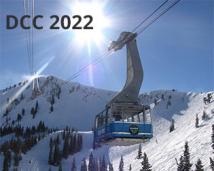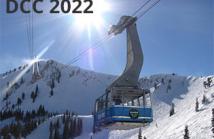
DCC 2022 Conference - The Data Compression Conference (DCC) is an international forum for current work on data compression and related applications. Both theoretical and experimental work are of interest. Visit the DCC 2022 website.

- Read more about Counting with Prediction: Rank and Select Queries with Adjusted Anchoring
- 1 comment
- Log in to post comments
Rank and select queries are the fundamental building blocks of the compressed data structures. On a given bit string of length n, counting the number of set bits up to a certain position is named as the rank, and finding the position of the kth set bit is the select query. We present a new data structure and the procedures on it to support rank/select operations.
- Categories:
 113 Views
113 Views
Gagie and Nekrich (2009) gave an algorithm for adaptive prefix-free coding that, given a string $S [1..n]$ over an alphabet of size $\sigma = o (n / \log^{5 / 2} n)$, encodes $S$ in at most $n (H + 1) + o (n)$ bits, where $H$ is the empirical entropy of $S$, such that encoding and decoding $S$ take $O (n)$ time. They also proved their bound on the encoding length is optimal, even when the empirical entropy is high. Their algorithm is impractical, however, because it uses complicated data structures.
simple_slides.pdf
- Categories:
 56 Views
56 Views
- Categories:
 84 Views
84 Views
- Read more about Information Preserving Dimensionality Reduction for Mutual Information Analysis of Deep Learning
- Log in to post comments
Mutual information has been actively investigated as a tool for analyzing neural networks' behavior, most notably the information bottleneck theory. However, estimating mutual information is a notoriously tricky task, especially for high-dimensional stochastic variables. Recently, mutual information neural estimation (MINE) was proposed as a non-parametric method to estimate mutual information for continuous variables without discretization. Unfortunately, MINE also produces significant errors for high-dimensional variables.
- Categories:
 47 Views
47 Views
- Read more about Lossy Compression of Gaussian Source Using Low Density Generator Matrix Codes
- Log in to post comments
We present a tandem scheme for Gaussian source compression, where a dead-zone quantizer is concatenated with a ternary low density generator matrix (LDGM) code. Both theoretical analysis and simulation results show that the LDGM codes can be universally optimal for near-lossless compression of ternary sources. Consequently, the distortion with the tandem scheme is mainly caused by the quantization, which can be negligible for high-rate quantizer. The most distinguished feature of the proposed scheme is its flexibility.
- Categories:
 65 Views
65 Views


- Read more about An Edge Aware Motion Modeling Technique Leveraging on the Discrete Cosine Basis Oriented Motion Model and Frame Super Resolution
- Log in to post comments
To capture motion homogeneity between successive frames, the edge position difference (EPD) measure based motion modeling (EPD-MM) has shown good motion compensation capabilities. The EPD-MM technique is underpinned by the fact that from one frame to next, edges map to edges and such mapping can be captured by an appropriate motion model. An example of such a motion model is the discrete cosine basis oriented (DCO) motion model, which can capture complex motion and has a smooth and sparse representation.
- Categories:
 50 Views
50 Views
- Read more about Iterative Machine-Learning-Based Method of Selecting Encoder Parameters for Speed-Bitrate Tradeoff
- Log in to post comments
Modern codecs offer numerous settings that can nonuniformly alter the encoding process. Some researchers have proposed video encoding multiobjective optimization, but none of these proposals addresses optimization of the entire encoder's option space when it is large. In this paper, we present a method for multiobjective encoding optimization of a given encoder in terms of relative video bitrate and encoding speed. The process takes place over one or more videos against a set of reference presets. It actively exploits similarities in the encoding process for similar videos.
DCC2022-v2.pdf
- Categories:
 225 Views
225 Views